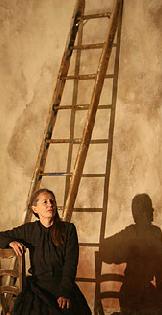SITE GUIDE
SEARCH
REVIEWS
FEATURES
NEWS
Etcetera and
Short Term Listings
LISTINGS
Broadway
Off-Broadway
NYC Restaurants
BOOKS and CDs
OTHER PLACES
Berkshires
London
California
DC
Philadelphia
Elsewhere
QUOTES
On TKTS
PLAYWRIGHTS' ALBUMS
LETTERS TO EDITOR
FILM
LINKS
MISCELLANEOUS
Free Updates
Masthead
Writing for Us
A CurtainUp Review
Kaos
By Elyse Sommer
|
I am a native son of Chaos; and not allegorically but in actual reality, for I was born in the country near a foresst called Càvuso, a dialectical corruption of the ancient Greek word, Khaos. —Luigi Pirandello. |

Daria Deflorian in Kaos.
(Photo: Joan Marcus) |
I loved her Chekhov inspired La Verse Flamme which I saw at Jacob's Pillow. Belle Epoque, about Toulouse-Lautrec, was visually impressive. Vienna Lusthaus, Clarke's last piece for New York Theatre Workshop, succeeded stunningly in evoking the erotically supercharged world of Vienna in the time of painters Gustav Klimt and Egon Schiel.
Luigi Pirandello is certainly distinguished and interesting enough to join the ranks of her previous art and literature linked works. However, these stories about Sicilian peasants at the turn of the century are woven into an unrelievedly dark tapestry.
The prologue showing the town's men preparing to leave their families for a mass exodus to America, establishes the stark black physical look and mood. It is followed by a piece about a mother (Daria Deflorian) begging the town doctor (Rocco Sisto) to write a letter to the sons with whom she's lost all contact and explaining why she can't accept her remaining son who is the product of her being repeatedly raped during some undefined conflict. There's also a story of a bride (Cristina Spina) who discovers that her husband (Vito Di Belita) goes beserk at each full moon. This is followed by a confrontation between a group of mountain peasants and the aristocratic land owner (Sisto again) who denies them the right to bury their dead on his property — with a follow-up piece in which a burial shows the peasants outwitting the aristocrat. A final epilogue has a man (Felix Blanka) trying to make sense of his dour memories.
The costumes, lighting and choreography are of a piece with these operatically tragic tales. The bleakness that the stage is enlivened by the dances, mostly at the end of each episode, that have the dancers spin and foot-stamp in circles and cast huge shadows against an upstage scrim. However, by the midway mark even these too infrequent choreographed scenes become monotonous.
Ms. Clarke credits a film (also called Kaos) by Paolo and Vittorio Taviani which first dramatized Pirandello's stories. Not having seen that film, I can't compare it with this piece, but playwright Frank Pugliese who collaborated with Ms. Clarke on this film to stage adaptation, is to be complemented for condensing its three-hour length into seventy minutes that, alas, feel like three hours — especially since the dialogue is in Italian and the English translations are projected on a corner of the back wall and often fly by so that the viewer is torn between watching and reading. My suggestion is to forget the projections and just enjoy the more enjoyable physical panorama.
LINKS
La Verse Flamme
Vienna Lusthaus (Revisited
Bell Epoque
| Kaos Directed and choreographed by Martha Clarke. Text adapted by Frank Pugliese from stories by Luigi Pirandello and the film by Paolo and Vittorio Taviani. In Italian with English super titles The Adapted pieces in order of appearance: Prologue Cast: Felix Blaska, Sophie Bortolussi, George De La Pena, Daria Deflorian, Vito Di Bella, Lorenzo Iacona, Jim Iorio, Gabrielle Malone, Matthew Mohr, Rocco Sisto, Cristina Spina, Rebecca Wender, Robert Wersinger, Julia Wilkins. Sets: Scott Pask Costumes: Donna Zakowska Lights: Christopher Akerlind Projection Design: Tal Jaffe Music Direction: Jill Jaffe with John T. La BarberaRunning Time: 70 minutes without intermission A New York Theater Workshop, 79 E. 4th St. (2nd Av/Bowery), 212/239-6200 From 11/10 to 12/04/06. Tues @ 7:00pm, Wed through Sat @ 8:00pm, Sat & Sun @ 2:00pm, Sun @ 7:00pm. Tickets: $65. Reviewed by Elyse Sommer based on December 3rd press performance |

Easy-on-the budget super gift for yourself and your musical loving friends. Tons of gorgeous pictures.

Leonard Maltin's 2007 Movie Guide

At This Theater
Leonard Maltin's 2005 Movie Guide

 >
>

